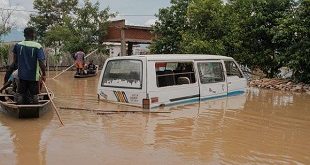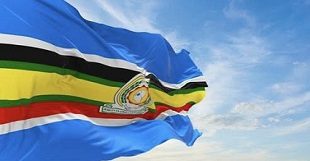
Why would the jumbos leave tranquil Queen Elizabeth Park for Congo’s volatile Virunga Park?
Kampala, Uganda | RONALD MUSOKE | Hundreds of elephants moving from Uganda’s Queen Elizabeth National Park to the Virunga National Park in eastern Democratic Republic of Congo have caused excitement in Virunga and nonchalant surprise in Uganda.
At the last count, Uganda had an estimated herd of about 6000 elephants, half of them in Queen Elizabeth National Park. Now, it appears, about 580 of these have shifted to Virunga.
Game rangers in Virunga have over the last five months been reveling in the arrival of the elephants; an event not witnessed in decades.
“For years I haven’t seen any animals when I flew over this area—just rebels,” Anthony Caere, an anti-poaching pilot at Virunga National Park told the non-profit Global Wildlife Conservation last December.
The rangers say as the elephants are tearing through trees and pummeling invasive bushes, they are also transforming the landscape back to a true grassland savanna. This is allowing the return of grazers and other wildlife species that have been absent from Virunga park for the last two decades: buffalo, the Ugandan kob, warthogs, topi, and even a pair of lions.
“Now, not only are we seeing the elephants which are an unbelievable sight from above, but we’re noticing the impact of such a big herd on the park. They’re restoring everything back to what it was 50 years ago and doing so much faster than we could have imagined. If the elephants continue to stay here in these numbers, this place will look totally different in just a few years.”
Meanwhile their Ugandan counterparts are studying the event. Many are assessing what could have prompted large herds of elephants to move at once to Congo in such big numbers. Will the elephants move back into Uganda and when?
Normal behaviour
Many conservationists familiar with elephant behaviour say it is normal for jumbo herds to move back and forth between Uganda’s Queen Elizabeth National Park and Virunga National Park in eastern Democratic Republic of Congo. This group says they see nothing unusual about the elephants’ migration patterns.
Some conservationists The Independent has talked to say the 7,769 km² wide Virunga National Park and the smaller 1,978 km² Queen Elizabeth National Park form a contiguous rangeland which also includes the Volcanoes National Park in Rwanda and the Rwenzori Mountains National Park in Uganda. Inside this large swathe of green shrubbery, grassland and forest space, elephants and other large mammals roam back and forth as they search for food, mating partners and safety.
“The animals do not care about international boundaries,” says Gladys Kalema Zikusoka, the founder and chief executive officer of Conservation Through Public Health (CTPH), a local conservation non-profit that promotes harmonious co-existence between wildlife and frontline communities.
Zikusoka’s junior colleague, Walter Odokorwot who is the coordinator of the Human-Wildlife Conflict management programme at CTPH, agrees. He has worked in the area for 27 years and knows a thing about elephant behaviour. He told The Independent recently that elephants trekking across this particular rangeland are common.
Pontious Ezuma, the Chief Warden of Queen Elizabeth National Park told The Independent on Jan. 28 that there is nothing unusual about elephant movements between these two parks.
“These elephants keep moving between these two parks and in fact, before the international borders were drawn, the original elephant migration pattern stretched from Sudan through what is now Murchison Falls National Park down to Queen Elizabeth National and Virunga,” he said.
John Makombo, the conservation manager at the Uganda Wildlife Authority told The Independent on Jan.25 that the Uganda Wildlife Authority has not seen any massive movement of elephants from Queen Elizabeth National Park to Virunga in the period stated. “Queen Elizabeth National Park is okay. All is well,” Makombo said.
Dr. Simon Nampindo, the Country Director of the Wildlife Conservation Society, Uganda Programme also told The Independent in an email response that in his 20 years of working in this particular landscape, the recent movement of elephants from Queen Elizabeth National Park to Virunga National Park is not a new phenomenon.
 The Independent Uganda: You get the Truth we Pay the Price
The Independent Uganda: You get the Truth we Pay the Price



Thank you Mr. Musoke and The Independent for this fascinating and wide-ranging article.
We at Space for Giants would wish only to make one small comment. Dr. Nampindo, among his insightful and learned remarks, suggests that there is “an electric fence around the Kyambura Wildlife Reserve in Uganda and another along the border of Virunga NP and Ishasha sector of Queen Elizabeth National Park”.
With great respect, we must report that this confuses the location of the fences that UWA with Space for Giants support has installed. At Kyambura Wildlife Reserve, the fence runs along the border of the Reserve, it does not go around it. It is 19.5km long, not 10km. This fence is at a significant distance from Virunga/the DR Congo border. There is no fence “along the border of Virunga NP”, only plans for one UWA wants to build. There is also no fence at “Ishasha sector”, again only plans for one that UWA wants to build. This point is important because as the report stands, it might be read to suggest that elephants habitually in the parts of QENP near to Virunga have moved to Virunga because of being shocked by electric fences, that can’t be the case as *there are no electric fences in those parts of QENP*.
Elephants do migrate far, so it’s feasible they might move from areas where there are fences all the way to Virunga, but to do so they need to cross significant areas of dense human habitation. That is unlikely for hundreds of elephants to be able to do.
There are two fences UWA has built with Space for Giants support. One running for 22.8km from Kasese town to the south, and the other mentioned above running 19.5km along the Kyambura WR border. Both are significant distances from the border with Virunga.
We trust that this comment will detract in no way from what is a very well researched and illuminating article into a fascinating topic. Again, thank you.
Space for Giants.
Suppose these beast do not return, what will become of our Queen Elizabeth National Park and how can we make claim on them?
In other words, it is high time these beast are electronically tagged so that we may know wherever they go back and forth, and dead or still alive.
Their major risk is that: in the volatile Eastern DR Congo (Failed State), they will be poached for their tasks (ivory) by all the different rebel groups in that part of the wilderness.
Hmmm, we know animals have a sense of impending geological catastrophes. Could this be the case here ? Remember the area in question is a geologically active area
“Zikusoka’s junior colleague, Walter Odokorwot who is the coordinator of the Human-Wildlife Conflict management programme at CTPH, agrees. He has worked in the area for 27 years and knows a thing about elephant behaviour.”
Someone who has worked in the area for 27 years cannot be called a “junior colleague”.